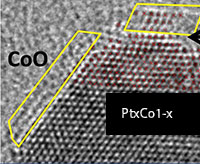Cobalt Migrates and Forms Islands in Two-Metal Catalysts
Chemical imaging technique provides insights for materials used in fuel production
(June 2014)

Cobalt oxide film on catalyst.
Results: Direct observation of atomic-level process of a platinum-cobalt nanoparticle catalyst reveals that the cobalt is far from stationary. A collaborative study including scientists at Pacific Northwest National Laboratory shows the cobalt migrates from deep inside the nanoparticle to the surface when surrounded by oxygen. When placed in hydrogen gas, the cobalt migrates back inside the nanoparticle, leaving a thin layer of platinum on the particle's surface.
Platinum-cobalt and other bimetallic catalysts are of interest because these materials often outperform single-metal catalysts. Further, these two-metal catalysts can be refined to improve their speed orefficiency in driving reactions such as converting hydrogen and carbon monoxide into the building blocks for chemicals or fuels.
This study was led by scientists at Lawrence Berkeley National Laboratory.
Why It Matters: To design fast, efficient, and long-lasting bimetallic catalysts, or to simply improve those in use today, means knowing how the morphology, structure and chemistry evolves under different conditions. The information the team captured provides insight for guiding the designing of new catalyst based on multi-component element for desired properties.
Read the press release on this research from Lawrence Berkeley National Laboratory at http://newscenter.lbl.gov/2014/06/06/evolution-of-a-bimetallic-nanocatalyst/.
Acknowledgments
Sponsors: H.L.X. was supported by Helios Solar Energy Research Center at Lawrence Berkeley National Laboratory. C.M.W. and L.K. were supported by the Chemical Imaging Initiative at PNNL. M.S. was supported by DOE's the Office of Basic Energy Sciences, Chemical Sciences, Geosciences, and Biosciences Division. R.T. was supported by H.Z.'s Early Career Research Program under the DOE Office of Science. H.Z. was a residency faculty of SinBeRise program of BEARS at University of California, Berkeley during July 2013-Jan. 2014.
Research Area: Chemical Imaging
Facilities: In situ environmental TEM experiments was carried out at the Environmental Molecular Sciences Laboratory; In situ work was conducted at the Center for Functional Nanomaterials; ex situ TEM experiments were done at the at National Center for Electron Microscopy
Research Team: Huolin L. Xin, Runzhe Tao, Lin-Wang Wang, Miquel Salmeron, Gabor A. Somorjai, and Haimei Zheng at Lawrence Berkeley National Laboratory, Selim Alayoglu at Lawrence Berkeley National Laboratory and University of California at Berkeley, Arda Genc at FEI Company, Chong-Min Wang and Libor Kovarik at Pacific Northwest National Laboratory, and Eric A. Stach at Brookhaven National Laboratory
Reference: Xin HL, S Alayoglu, R Tao, A Genc, CM Wang, L Kovarik, EA Stach, LW Wang, M Salmeron, GA Somorjai, and H Zheng. 2014. "Revealing the Atomic estructuring of Pt-Co Nanoparticles." Nano Letters 14(6):3203-3207. DOI: 10.1021/nl500553a
